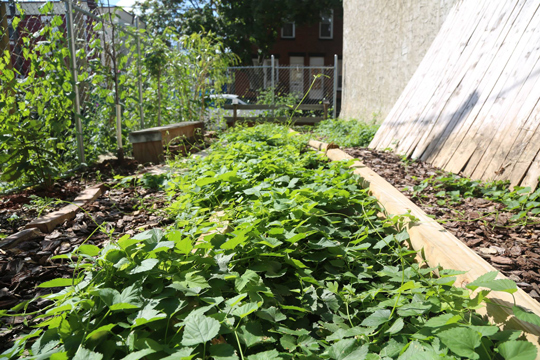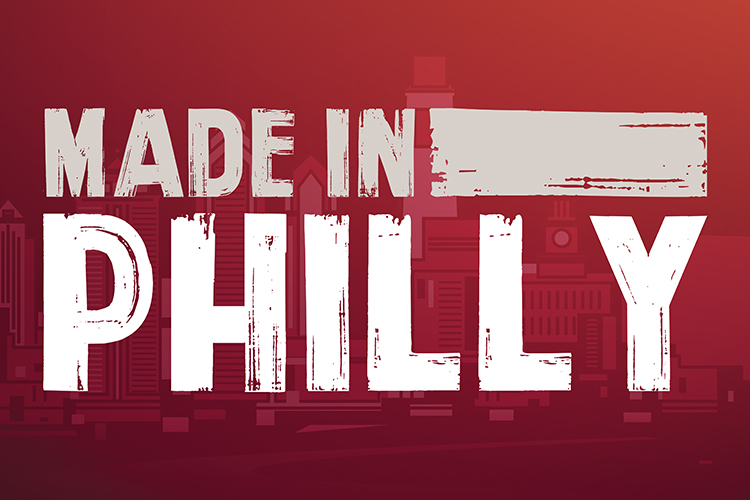 Filmmaker and activist Jamie Moffett harvested Cascade and Nugget hop vines he and neighbors planted in their “Guerrilla Hops Garden” along Rand Street in June 2013. Photo by Jamie Moffett.
Filmmaker and activist Jamie Moffett harvested Cascade and Nugget hop vines he and neighbors planted in their “Guerrilla Hops Garden” along Rand Street in June 2013. Photo by Jamie Moffett.
For some beer enthusiasts, hops—pungent, cone-shaped flowers whose acidic resin gives beer bitterness and aroma—are what define a good glass of suds. Many beers use hops that come from European brewing centers, but even the domestic hops in local India pale ales usually arrive from suppliers in the Pacific Northwest. While our region has a burgeoning local brewery scene and the hops can be grown here, the overwhelming majority of the hops in their brews come from far-off places because it’s still cheaper and easier to buy from elsewhere.
Victory Brewing in Downingtown, Pa., draws the water for its beer from the state, but its Yakima Glory beer, named after a famous hop-growing region in Washington State, uses mostly Northwest hops. Victory was one of several breweries to explore local hop sources when a global hop shortage drove up prices and made some varieties impossible to get in 2008. Reports from the brewing industry at the time attributed the shortage to a “perfect storm” of conditions that included actual storms and drought in Europe, long-term market forces such as a stockpiling of hop extract used by huge commercial brewers, and even a warehouse fire that wiped out a chunk of Washington State’s surplus hops. At the peak of the shortage, Brew Your Own magazine noted some hop varieties had jumped in cost from $3 per pound to $26.
Because of the shortage, Victory made Vista Farms Harvest Ale using Lehigh Valley hops, which they used again in 2009. But the 2010-2013 batches of Harvest Ale didn’t contain local hops, spokeswoman Melissa Thomas says. The hop shortage in 2008 also inspired Weyerbacher Brewing Company in Easton, Pa., to plant some 1,500 hop vines in Lehigh County. The crop from that hop yard went into batches of its now-discontinued Harvest Ale, but Bill Bragg, public relations and visitors center manager at Weyerbacher, says they’ve since moved back to using West Coast hop suppliers. Dan Weirback, co-owner at Weyerbacher was the driving force behind using local hops, but says they’ve since mowed the vines down because of the hard farm work and long hours needed to tend a hop field big enough to supply a crop for the brewery.
“Enormous amounts of sheer back-breaking labor and no return were why we gave it up,” Weirback says. “Sure, we got money for the hops, but after four years we still hadn’t recovered all we had to put into it. Even if we had a picking machine, the amount of manual labor is ridiculous.”
Although the Philadelphia area doesn’t fall into the 48th latitude—a band of geography that stretches from New York to the Pacific Northwest with the ideal amount of sunlight for hops—many local homebrewers with robust hop gardens can attest to our climate’s compatibility with hop vines. The Oregon Hop Commission, a group of farmers that helps set hop prices in that state, say that hops are limited to latitudes between 35 and 55 degrees, an area that covers Pennsylvania and surrounding states. Key is a wet spring followed by a warm summer, which helps fight off root rot and powdery mildew. Considering that’s normal weather for the area, it’s not a surprise to see plenty of healthy local hop vines. Weirback estimates his annual harvest from 2008 to 2011 yielded 500 pounds of fresh hops.
One of the few places to get a taste of local hops is not from the Pennsylvania hinterlands, but from Kensington. Philadelphia Brewing Company co-owner Nancy Barton says the bulk of the hops that go into their Harvest From the Hood beer come from hops grown in the brewery courtyard, from nearby Greensgrow Farms, and from vines planted at Gloria Dei (Old Swedes’) Episcopal Church and O’Neals Pub in South Philadelphia. Since 2008, PBC harvested the urban hop collections as the flowers begin to dry on the vine in October. Unlike most hops, these aren’t preserved for later use, but are thrown fresh into the boiling beer, which is only brewed in the fall as the hops are picked.
“The day we are going to brew, we go around and pick the hops,” Barton says. “The beer is super hoppy, and you can really taste that fresh hop flavor.” She adds that the two batches of Harvest From the Hood beer—sold in kegs and 22-ounce bottles—sell extremely quickly, in part because a truly local harvest ale like theirs is such a rarity.
Last summer, filmmaker and activist Jamie Moffett harvested from the rows of Cascade and Nugget hop vines he and some neighbors planted in their “Guerrilla Hops Garden” along Rand Street in June 2013. In an effort to raise money to buy the lot and pay for upkeep, Moffett plans to sell the hops through Greensgrow Farms and the nearby Philly Homebrew Outlet. Because they planted too late in the year, their 2013 harvest was just a few ounces, but they’re hoping for better results when the plants have their first full season this year.
In Bucks County, the Free Will Brewing Co., now in its second year, is looking toward the future after planting 40 hop vines in 2013. Because it takes several years for hop vines to mature and begin producing heavy yields, the brewery says their first limited harvest won’t be until next year. Like PBC, co-owner Dominic Capece envisions making a small batch of harvest ale using the fresh local hops, but doesn’t see using them for more than that. “Overall, what we can produce is a pretty trivial amount compared to what we need to make most of our beers,” Capece says.
Matthew Gouwens, owner and brewer at Hop Farm Brewing Company outside Pittsburgh, has been growing his own hops and making beer as a home-brewer for seven years. After opening the brewery in September 2013, he spent months trying to convince local farmers to dedicate acreage to hops. While he did get one grower to plant hops that will go into his beers, he says many are reluctant to get on board because of the years-long wait for a bumper crop and the need for specialized equipment, such as pickers and dryers.
“Most farmers want to plant corn and get paid for it that year,” Gouwens says. “It takes a special kind of farmer to take a risk and get involved with this.”
Still, he hopes to have his brewery using all local hops within the first 10 years, and says a number of his beers are already using about a quarter of their hops from local sources. He also thinks that, as local breweries become more established, they will drive up the demand for people to grow hops locally.
“People want to drink local, and I think more and more that desire is going to extend to what the beer is made with just as much as where it’s made,” Gouwens says.
To learn more about the “Guerrilla Hops Garden” and other projects visit facebook.com/kensingtonrenewal.
story by Brian Rademaekers








